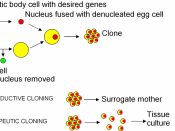Since the late seventies scientists have been cloning mammals using cells taken from embryos. In July 1996, medical history was made when a sheep named Dolly was cloned. The only thing that set Dolly the sheep apart from the other clones was that she was cloned from an adult sheep cell. Before Dolly was cloned, scientists thought adult cell cloning was impossible. A clone is defined as a group of genetically identical cells. The goals and purposes for cloning range from making copies of those that have deceased to better engineering the offspring in humans and animals. Cloning could also offer a means of curing diseases. Cloning has many benefits that could be used as an aid to the human race, but there is also the ethical debate over cloning. Many people believe it will do damage to mankind. Some feel it is against God's will, while others fear deformity and emotional stress in the human clone.
Despite the ongoing debate, cloning produces many advances for the human race. Cloning has already made advances from the cloning animals. Embryo splitting was developed in the eighties and is used by ranchers and livestock breeders. Through this process, farmers can twin their best animals and plants for better production. "The Future of Cloning" states that "Mammalian cloning research would allow genetic manipulation to produce animals that are disease resistant" (1). Cloning techniques are also being used in agriculture. It is used to produce higher yield, better quality fruits and vegetables. "Ethical Concerns" states that, "Transgenic animals (animals engineered to carry genes from species other than their own) can be made to produce a wide variety of protein that could be sold as drugs, as well as proteins, called enzymes, that can be used to speed up chemical reactions."(1). Animals could be...



Prefect
For 2 and a half hours, this essay is, well, perfect.
2 out of 3 people found this comment useful.